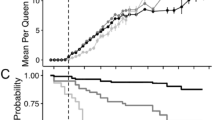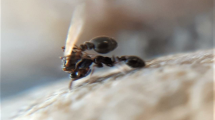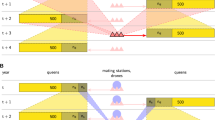Abstract
The evolution of social behaviour has posed a special problem for natural selection theory since Darwin. Sociality entails at least a partial loss of personal reproduction by some individuals, a seeming contradiction to the expectation that it be maximized by natural selection. The theory of kin selection1,2 seeks to explain social evolution by reference to high degrees of genetic relatedness among cooperating individuals. In the most diverse and conspicuous of social organisms, the social Hymenoptera (ants, bees, wasps), kin selection theory has been especially attractive because the malehaploid genetic system of the group leads to potentially high relatedness among female nestmates3–5. Multiple mating by queens poses a serious difficulty for kin selection, however, in that it reduces nestmate relatedness unless sperm from different males are used non-randomly6–10. This possibility has been investigated in only one highly social insect, the honey bee Apis mellifera, where the absence of suitable genetic markers has necessitated the use of artificial insemination10,11. In this first study of long-term sperm utilization in natural populations of highly social insects I show that queens of two social wasp species use sperm from different males in relatively constant proportions through time, resulting in consistently low relatedness among female nestmates. I also show that workers do not supplement their inclusive fitness by reproducing directly in colonies in which the mother queen is present.
This is a preview of subscription content, access via your institution
Access options
Subscribe to this journal
Receive 51 print issues and online access
$199.00 per year
only $3.90 per issue
Buy this article
- Purchase on Springer Link
- Instant access to full article PDF
Prices may be subject to local taxes which are calculated during checkout
Similar content being viewed by others
References
Hamilton, W. D. J. theor. Biol. 7, 1–52 (1964).
Maynard Smith, J. Nature 201, 1145–1147 (1964).
Wilson, E. O. The Insect Societies (Belknap, Cambridge, 1971).
Crozier, R. H. in Social Insects, Vol. 1 (ed. Hermann, H.) 223–287 (Academic, New York, 1979).
Starr, C. K. in Social Insects, Vol. 1 (ed. Hermann, H.) 35–79 (Academic, New York, 1979).
Hamilton, W. D. A. Rev. Ecol. Syst. 3, 193–232 (1972).
West-Eberhard, M. J. Q. Rev. Biol. 50, 1–33 (1975).
Crozier, R. H. & Brückner, D. Am. Nat. 117, 561–563 (1981).
Starr, C. K. in Sperm Competition and the Evolution of Animal Mating Systems (ed. Smith, R. L.) 427–464 (Academic, New York, 1984).
Page, R. E. A. Rev. Entomol. 31, 297–320 (1986).
Laidlaw, H. H. & Page, R.E. Genetics 108, 985–997 (1984).
Archer, M. E. in Social Wasps, Their Biology and Control (ed. Edwards, R.) 172–207 (Rentokil, East Grinstead, 1980).
Iwasa, Y. J. theor. Biol. 93, 125–142 (1981).
Bartz, S. H. Behav. Ecol. Sociobiol. 11, 223–228 (1982).
Pamilo, P., Behav. Ecol. Sociobiol. 15, 241–248 (1984).
Fletcher, D. J. C. & Ross, K. G. A. Rev. Entomol. 30, 319–343 (1985).
Ross, K. G. J. Zool. (Lond.) 205, 411–424 (1985).
Ross, K. G. & Fletcher, D. J. C. Behav. Ecol. Sociobiol. 17, 349–356 (1985).
West-Eberhard, M. J. in Natural Selection and Social Behavior: Recent Research and New Theory (eds Alexander, R. D. & Tinkle, D. W.) 3–17 (Chiron, New York, 1981).
Alexander, R. D. A. Rev. Ecol. Syst. 5, 325–383 (1974).
Evans, H. E. Bioscience 27, 613–617 (1977).
Crozier, R. H. & Page, R. E. Behav. Ecol. Sociobiol. 18, 105–115 (1985).
Pamilo, P. Genetics 107, 307–320 (1984).
Wade, M. J. J. theor. Biol. 95, 351–368 (1982).
Ross, K. G., Fletcher, D. J. C. & May, B. Biochem. Syst. Ecol. 13, 29–33 (1985).
Ishay, J. Anim. Behav. 23, 425–431 (1975).
MacDonald, J. F. & Matthews, R. W. J. Kans. ent. Soc. 54, 433–457 (1981).
MacDonald, J. F. & Matthews, R. W. J Kans. ent. Soc. 57, 134–151 (1984).
Author information
Authors and Affiliations
Rights and permissions
About this article
Cite this article
Ross, K. Kin selection and the problem of sperm utilization in social insects. Nature 323, 798–800 (1986). https://doi.org/10.1038/323798a0
Received:
Accepted:
Issue Date:
DOI: https://doi.org/10.1038/323798a0
This article is cited by
-
Males, but not females, mate with multiple partners: a laboratory study of a primitively eusocial wasp Ropalidia marginata
Insectes Sociaux (2012)
-
Queen, worker, and male yellowjacket wasps receive different nutrition during development
Insectes Sociaux (2012)
-
Does a polyandrous honeybee queen improve through patriline diversity the activity of her colony’s scouting foragers?
Behavioral Ecology and Sociobiology (2011)
-
Colony kin structure and breeding patterns in the social wasp, Polistes biglumis
Insectes Sociaux (2011)
-
Promiscuous honeybee queens generate colonies with a critical minority of waggle-dancing foragers
Behavioral Ecology and Sociobiology (2010)
Comments
By submitting a comment you agree to abide by our Terms and Community Guidelines. If you find something abusive or that does not comply with our terms or guidelines please flag it as inappropriate.



